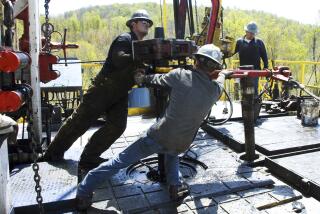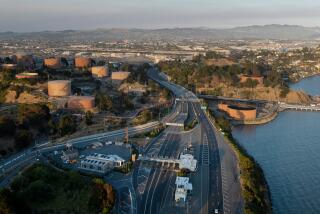Fracking brings oil boom to south Texas town, for a price
CARRIZO SPRINGS, Texas — Just a few years ago this was a sleepy town of 5,600, and people eked out a living from the land. They farmed, worked ranches and leased their property to hunters to make a few dollars.
Now, an oil and gas boom is transforming the economy of south Texas, turning Carrizo Springs into a busy city of at least 40,000.
Texas oil companies, tapping a vast formation called the Eagle Ford shale, have nearly doubled oil production over the last two years and by next year are expected to produce 4 million barrels a day. That would catapult Texas ahead of Iran, Iraq and the United Arab Emirates to become the fifth-biggest oil producer in the world.
Property owners who have seen the state’s fortunes rise and fall during oil booms in years past — before the aging oil wells that first spurted “Texas tea” went dry — are suddenly making new millions selling and leasing, earning them the nickname “Eagle Ford Hillbillies.” The region is set to reap more than $90 billion in the next decade.
But the newfound prosperity comes at a price. The highway leading into Carrizo Springs is cracked and pitted from the heavy traffic. Sexual assaults, thefts and crashes are up. Women frequent parking lots selling perfume — a pretext for prostitution. There’s a new strip club.
The sheriff has hired 15 deputies — doubling the force — and complains that Mexican drug cartels are taking advantage of the chaotic atmosphere, using fake oil trucks to conceal and transport narcotics.
Unemployment dropped from 12% to 4% countywide in the last five years. Help is wanted at the nearby Oil Patch Cafe, Dairy Queen, Church’s Chicken and pretty much every restaurant around. Roadside signs advertise pipeline supply services, shale tank trucks and temporary oil field housing — complete with gourmet chefs and maid service.
At quitting time, fleets of white energy company trucks occupy the parking lots. Companies have pitched more than a dozen military-style man camps, or temporary housing complexes, spartan and secure as overseas military bases. RV parks multiplied alongside them, from two at the start of the boom to 70.
The number of hotels tripled. So did membership in the chamber of commerce, and city sales tax revenues.
Mayor Adrian DeLeon, who has been expanding his convenience store and restaurant to cater to oil workers, is talking about starting a community college.
The challenge of managing a boom is similar to managing a drilling operation, said Michael Webber, deputy director of the University of Texas at Austin’s Energy Institute: “How do we harness as much good from it without getting left with just a bad residue?”
The trick, he said, is not to drill too hard too fast. Instead, smart drillers milk the oil field slowly for all it’s worth.
“If the cities are smart, they’ll do the same thing,” Webber said.
The boom has enriched scores of small towns in more than a dozen rural counties in south Texas not known for oil and gas exploration. Oil had a brief heyday here in the 1980s, but has never defined the economy and culture the way it has in Houston and West Texas.
That changed in 2008, when new drilling technology for hydraulic fracturing, or fracking, tapped a rich Texas shale formation running 50 miles wide and 400 miles long. It was named after the town where it was discovered: Eagle Ford.
As of last month, 5,021 oil and 2,468 gas wells had been drilled across the shale, with an additional 5,504 permitted, according to the permitting agency, the Texas Railroad Commission. Back in 2008, only 26 permits had been issued for Eagle Ford shale.
Drilling operations are visible from space. At night a golden arc of light — from natural gas flaring and electrical lights on drilling platforms — sweeps east from Carrizo Springs to the heart of Texas. By 2022, the deposits are expected to generate 128,000 jobs and untold side effects across the region.
“This is transitional for south Texas — it gives us the opportunity to create new communities,” said Leodoro Martinez Jr., who leads the Eagle Ford Shale Consortium, a group of local leaders.
Eagle Ford is not the only shale boom in the state. West Texas, traditional oil country, is booming again thanks to its own shale in the Permian Basin.
Texas companies were producing 2.7 million barrels of oil a day last fall — more than every other top oil-producing state, including Alaska, California, North Dakota and Wyoming, according to the U.S. Energy Information Administration. Last week, officials at one of the largest oil producers in the country, Occidental Petroleum, announced plans to move its headquarters from Los Angeles to Houston.
Texas oil production is projected to surpass 3 million barrels a day this year and to reach 4 million a day next year.
It’s not clear how long the Eagle Ford boom will last. Some experts forecast a decade of productive drilling, others 50 years.
Companies weigh oil prices against the cost of fracking, which is heavily dependent on water that has become increasingly scarce across Texas. In Carrizo Springs, the water supply is already heavily tapped by area ranchers and farmers.
Ramon Botello, 58, a car salesman who has benefited from increased business, worries that wastewater from fracking will contaminate groundwater and local wells. Some days, as he drives into town, he smells an odor that’s new here but familiar in oil and gas country: like rotten eggs.
“What’s going to be left for people who live here? What effect are they going to have on us?” Botello said of the energy companies.
Fracking wastewater may bubble up through old, uncapped wells, said Jean-Philippe Nicot, a research scientist at the University of Texas at Austin’s Bureau of Economic Geology. Carrizo Springs has already seen some old wells overflow, the mayor said, and he’s trying to cap them.
Many residents also want to avoid mistakes made by boom towns that collapsed after oil and gas prices dropped.
“Every day we get with it is a blessing because it’s more than we had before. But it’s scary to have your eggs all in one basket,” said Claudia McDaniel, who runs the Carrizo Springs Javelin newspaper.
Lawyer Alfredo Padilla, 57, leased some of his land to energy companies and has already made a quarter of a million dollars in royalties. He works with the companies and locals who have made millions and can afford to drive two hours to luxury-shop in San Antonio.
“You go to the high-dollar furniture stores, and they know Carrizo Springs,” Padilla said.
But he has also seen poor families forced to double and triple up with relatives as rents increased.
“We went from poor people renting trailers for $300, $400 a month, to now they’re getting kicked out. That’s a big problem,” said Padilla, who serves on the local housing board.
At the Wal-Mart one Sunday, mothers in minivans and elderly ladies in dusty sedans parked beside flashy $60,000 pickups driven by oil riggers, some with middle-school educations and six-figure salaries.
Irma Estrada, 68, loaded her sedan. Today she found everything she needed. Sometimes she has to drive 50 miles to the next closest Wal-Mart in Uvalde because oil workers have picked the shelves clean.
Estrada steeled herself to hit the road. Oil field shifts overlap in the morning and evening, doubling the traffic. Restaurants have started serving beer at breakfast.
“It’s a lot of traffic. More dangerous, I think, too,” she said. “I’m kind of scared.”
Across the street, oil and gas workers crowded plywood tables at Lee’s Steakhouse beneath a wall of mounted deer, wild pig and caribou heads.
Lee Vallejo opened 16 years ago. Soon after the boom started, his daughter Leslie Ramirez, 31, quit her teaching job to help. They expanded their staff and menu, adding larger steaks and outdoor mesquite grilling nights. They slapped a bumper sticker on the front door, “I love Eagle Ford.”
As the boom spread to neighboring towns, Vallejo reduced his staff.
A new restaurant has opened across the street: Red Dog Ice House, an eatery that’s oil- and gas-themed, with workers’ hats and jumpsuits tacked to the walls. Two more locations are opening in nearby towns. And unlike Lee’s Steakhouse, they’re designed to be portable, able to relocate as the boom moves on.
More to Read
Sign up for Essential California
The most important California stories and recommendations in your inbox every morning.
You may occasionally receive promotional content from the Los Angeles Times.











